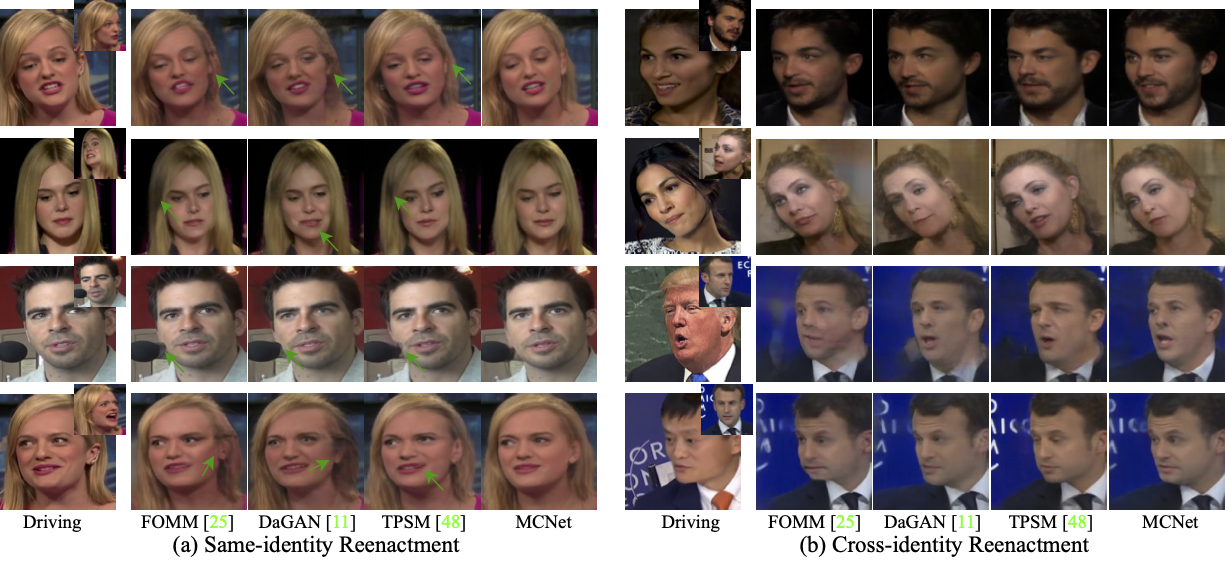📖 Implicit Identity Representation Conditioned Memory Compensation Network for Talking Head Video Generation (ICCV 2023)
🔥 If MCNet is helpful in your photos/projects, please help to ⭐ it or recommend it to your friends. Thanks🔥
Fa-Ting Hong, Dan Xu
The Hong Kong University of Science and Technology
mcnet-.01_1.-.Compressed.with.FlexClip.mp4
🚩 Updates
- 🔥🔥✅ July 20 2023: Our new talking head work MCNet was accpted by ICCV2023. The code will be released in ten days. You can talk a look at our previous work DaGAN first.
- Python >= 3.7 (Recommend to use Anaconda or Miniconda)
- PyTorch >= 1.7
- Option: NVIDIA GPU + CUDA
- Option: Linux
We now provide a clean version of MCNet, which does not require customized CUDA extensions.
-
Clone repo
git clone https://github.com/harlanhong/ICCV2023-MCNET.git cd ICCV2023-MCNET -
Install dependent packages
pip install -r requirements.txt ## Install the Face Alignment lib cd face-alignment pip install -r requirements.txt python setup.py install
We take the paper version for an example. More models can be found here.
See config/vox-256.yaml to get description of each parameter.
The pre-trained checkpoint of face depth network and our MCNet checkpoints can be found under following link: OneDrive.
Inference! To run a demo, download checkpoint and run the following command:
CUDA_VISIBLE_DEVICES=0 python demo.py --config config/vox-256.yaml --driving_video path/to/driving --source_image path/to/source --checkpoint path/to/checkpoint --relative --adapt_scale --kp_num 15 --generator Unet_Generator_keypoint_aware --result_video path/to/result --mbunit ExpendMemoryUnit --memsize 1 The result will be stored in path/to/result. The driving videos and source images should be cropped before it can be used in our method. To obtain some semi-automatic crop suggestions you can use python crop-video.py --inp some_youtube_video.mp4. It will generate commands for crops using ffmpeg.
- VoxCeleb. Please follow the instruction from https://github.com/AliaksandrSiarohin/video-preprocessing.
To train a model on specific dataset run:
CUDA_VISIBLE_DEVICES=0 python -m torch.distributed.launch --master_addr="0.0.0.0" --master_port=12347 run.py --config config/vox-256.yaml --name MCNet --batchsize 8 --kp_num 15 --generator Unet_Generator_keypoint_aware --GFM GeneratorFullModel --memsize 1 --kp_distance 10 --feat_consistent 10 --generator_gan 0 --mbunit ExpendMemoryUnit
The code will create a folder in the log directory (each run will create a new name-specific directory).
Checkpoints will be saved to this folder.
To check the loss values during training see log.txt.
By default the batch size is tunned to run on 8 GeForce RTX 3090 gpu (You can obtain the best performance after about 150 epochs). You can change the batch size in the train_params in .yaml file.
Also, you can watch the training loss by running the following command:
tensorboard --logdir log/MCNet/logWhen you kill your process for some reasons in the middle of training, a zombie process may occur, you can kill it using our provided tool:
python kill_port.py PORT-
Resize all the videos to the same size e.g 256x256, the videos can be in '.gif', '.mp4' or folder with images. We recommend the later, for each video make a separate folder with all the frames in '.png' format. This format is loss-less, and it has better i/o performance.
-
Create a folder
data/dataset_namewith 2 subfolderstrainandtest, put training videos in thetrainand testing in thetest. -
Create a config
config/dataset_name.yaml, in dataset_params specify the root dir theroot_dir: data/dataset_name. Also adjust the number of epoch in train_params.
Our MCNet implementation is inspired by FOMM. We appreciate the authors of FOMM for making their codes available to public.
@inproceedings{hong23implicit,
title={Implicit Identity Representation Conditioned Memory Compensation Network for Talking Head video Generation},
author={Hong, Fa-Ting and Xu, Dan},
booktitle={ICCV},
year={2023}
}
@inproceedings{hong2022depth,
title={Depth-Aware Generative Adversarial Network for Talking Head Video Generation},
author={Hong, Fa-Ting and Zhang, Longhao and Shen, Li and Xu, Dan},
journal={IEEE/CVF Conference on Computer Vision and Pattern Recognition (CVPR)},
year={2022}
}
@inproceedings{hong2023depth,
title={DaGAN++: Depth-Aware Generative Adversarial Network for Talking Head Video Generation},
author={Hong, Fa-Ting and and Shen, Li and Xu, Dan},
journal={arXiv preprint arXiv:2305.06225},
year={2023}
}
If you have any question or collaboration need (research purpose or commercial purpose), please email [email protected].
